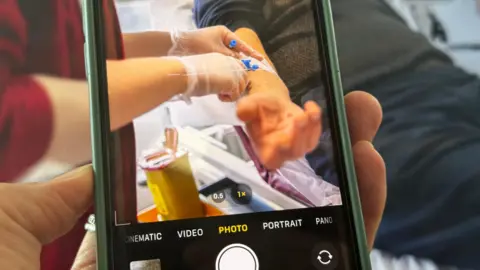In recent discussions at the Society of Radiographers (SoR) annual conference, concerns have been raised about patients filming their medical treatments to share on social media platforms like TikTok and Instagram. The potential implications of this behavior are serious, according to health professionals who warn that such actions could jeopardize not only the confidentiality of medical information but also the overall safety and comfort of patients and NHS staff.
A growing trend has emerged where increasingly more patients choose to document their medical experiences using mobile phones. However, this often occurs without prior consent from healthcare providers, creating an unsettling atmosphere in clinical environments. The SoR emphasized that filming procedures can lead to distractions and result in anxiety amongst medical personnel, who are striving to focus on delivering quality care. The risk of accidental disclosure of sensitive medical data concerning other patients in the vicinity adds another layer of concern.
Ashley d’Aquino, a therapeutic radiographer from London, recounted an experience during her practice where a patient’s relative began filming during a procedure. This took place at a time when she was focused on executing critical aspects of treatment, underscoring the disruptive nature of unsolicited recording. d’Aquino, who is also a local union representative, highlighted how such incidents are not isolated, noting that colleagues have shared similar experiences of being filmed without approval.
One notable example raised by Ms. d’Aquino involved a staff member who had initially agreed to take photographs for a patient. However, upon handing over the phone, it became clear that the patient had secretly recorded the healthcare worker during the process, intending to publish it online as part of a blog focused on her cancer journey. This incident illustrates how personal intentions can cross professional boundaries, leading to potential breaches of trust and privacy within healthcare settings.
NHS staff typically wear identification badges, which could render their names and job titles visible in videos shared online. Such exposure raises significant concerns about professional boundaries. A department assistant, who was engaged in a patient procedure, reported an unsettling experience where the patient’s 19-year-old daughter filmed without permission, claiming it would be amusing for her followers on social media. The staff member recounted feelings of dread and self-doubt following the incident, questioning whether the action compromised the quality of care delivered.
The situation demands clear guidelines from healthcare institutions. d’Aquino noted that while recording medical consultations can aid patients, particularly in understanding complex information, the pervasive nature of smartphones today has normalized filming without the necessary precautions. Dean Rogers, the SoR’s director of strategy, called upon NHS trusts to establish stringent policies that prevent patients from recording treatments without explicit consent. He posed crucial questions about whether such recordings violate the privacy of other patients and interfere with the capacity to deliver necessary care.
Prof. Meghana Pandit, co-national medical director at NHS England, also echoed the need for clear communication regarding recording practices. She advised that patients wishing to film any aspect of their NHS care should engage in prior discussions with healthcare staff, asserting that such recordings should only be for personal use. She emphasized the potential risk to confidentiality when other patients are recorded without their consent, underscoring that information related to others’ diagnoses and treatments should never be captured or broadcasted on social media.
In conclusion, the rapid proliferation of smartphone use in healthcare contexts presents both opportunities and challenges. While there are valid reasons for recording medical consultations, appropriate safeguards must be in place to ensure that sensitive information remains private, and the integrity of patient care is maintained. Clear policies and respectful engagement between patients and healthcare professionals are essential for mitigating risks associated with filming within clinical settings.



